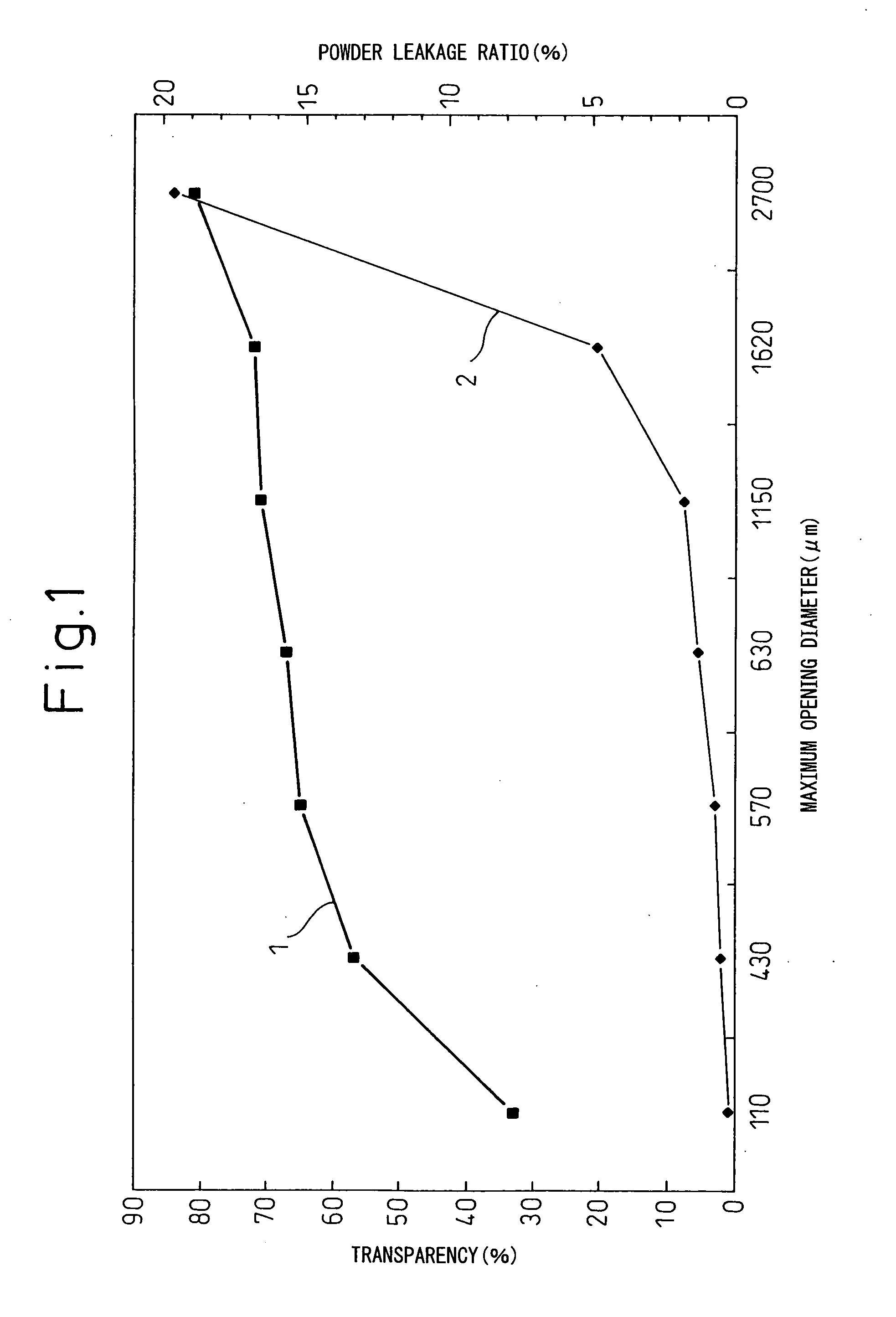Nonwoven fabric and tea bag
a nonwoven fabric and tea bag technology, applied in the field of nonwoven fabric and tea bags, can solve the problems of poor transparency of paper, inability to heat seal paper, and inability to observe tea leaves in tea bags, and achieve the effects of good swelling and spreading of tea leaves, good tea extraction effect, and good tea sta
- Summary
- Abstract
- Description
- Claims
- Application Information
AI Technical Summary
Benefits of technology
Problems solved by technology
Method used
Image
Examples
examples 1 to 5
, COMPARATIVE EXAMPLES 1 TO 2
[0085] A known spun bond method was used. A polypropylene resin showing a MFR of 39, and having a titanium oxide content of 0.1% by weight was spun through a spinneret by a melt spinning system. The spun yarn was drawn with a high speed drawing apparatus, opened, and collected to give a fiber web. The procedure was repeated while a fabric weight and a yarn diameter were varied to give various webs. Each web was then heat contact bonded by heat pressing between an emboss roll and a smooth roll to give a spun-bonded, partial heat contact bonded nonwoven fabric of polypropylene filaments yarn.
[0086] In any of Examples 1 to 5, each nonwoven fabric was then coated with a sorbitan aliphatic acid ester as a hydrophilic agent by a gravure roll system in an amount of 0.2 to 2.0% by weight, and dried at 130° C. to give a coated nonwoven fabric. In addition, the nonwoven fabrics were not coated with the hydrophilic agent in Comparative Examples 1 to 3.
[0087] Furt...
examples 6 to 10
, COMPARATIVE EXAMPLES 4 TO 5
[0091] A partially heat contact bonded, spin-bonded nonwoven fabric of a polyester filaments yarn was obtained in the same manner as in Example 1 except that a bright resin of a poly(ethylene terephthalate) (intrinsic viscosity of 0.76, titanium oxide content of 0.05% by weight) was used in place of the polypropylene resin.
[0092] The nonwoven fabrics were then coated with a sorbitan aliphatic acid ester as a hydrophilic agent in an amount of 0.1 to 0.5% by weight with a gravure roll, and dried at 130° C. In addition, the nonwoven fabrics in Comparative Examples 4 and 5 were not coated with a hydrophilic agent.
[0093] Furthermore, in each of Examples 9 and 10, two types of thermoplastic synthetic fiber webs differing from each other in a yarn diameter and a fabric weight were used as an upper layer and a lower layer, respectively, to give a laminate of nonwoven fabrics.
[0094] Table 2 shows properties of the nonwoven fabrics thus obtained. In addition, t...
examples 11 to 15
, COMPARATIVE EXAMPLES 6 TO 7
[0097] A partially heat contact bonded nonwoven fabric of an aliphatic polyester filaments yarn was obtained in the same manner as in Example 1 except that a biodegradable resin (titanium oxide content of 0.03% by weight) of a poly(lactic acid)(copolymerization ratio (molecular ratio) of D form / L form of 1.5 / 98.5; melting point of 173° C.; MFR of 13 g / 10 min) was used in place of the polypropylene resin.
[0098] The nonwoven fabrics were then coated with a sorbitan aliphatic acid ester as a hydrophilic agent in an amount of 0.2% by weight with a gravure roll, and dried at 130° C. In addition, the fabrics in Comparative Examples 6 and 7 were not coated with a hydrophilic agent.
[0099] Furthermore, in each of Examples 14 and 15, two types of thermoplastic synthetic fiber webs differing from each other in a yarn diameter and a fabric weight were used as an upper layer and a lower layer, respectively, to give a laminate of nonwoven fabrics.
[0100] Table 3 sho...
PUM
| Property | Measurement | Unit |
|---|---|---|
| thickness | aaaaa | aaaaa |
| thickness | aaaaa | aaaaa |
| transparency | aaaaa | aaaaa |
Abstract
Description
Claims
Application Information
 Login to View More
Login to View More - R&D
- Intellectual Property
- Life Sciences
- Materials
- Tech Scout
- Unparalleled Data Quality
- Higher Quality Content
- 60% Fewer Hallucinations
Browse by: Latest US Patents, China's latest patents, Technical Efficacy Thesaurus, Application Domain, Technology Topic, Popular Technical Reports.
© 2025 PatSnap. All rights reserved.Legal|Privacy policy|Modern Slavery Act Transparency Statement|Sitemap|About US| Contact US: help@patsnap.com

